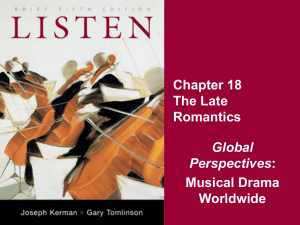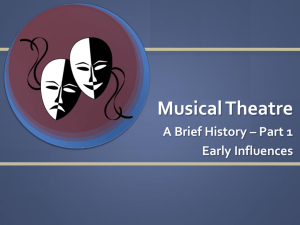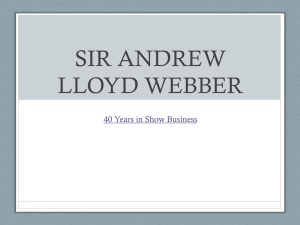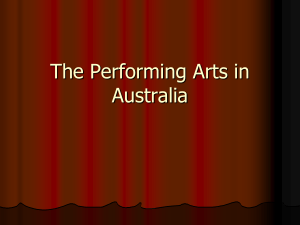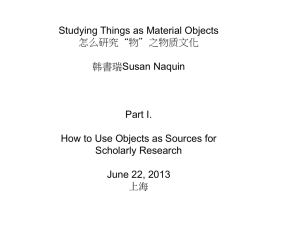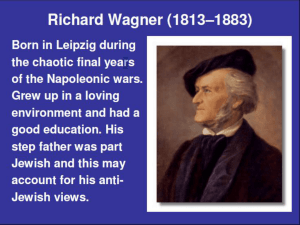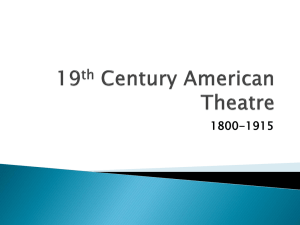Shanghai Yue opera presentation
advertisement
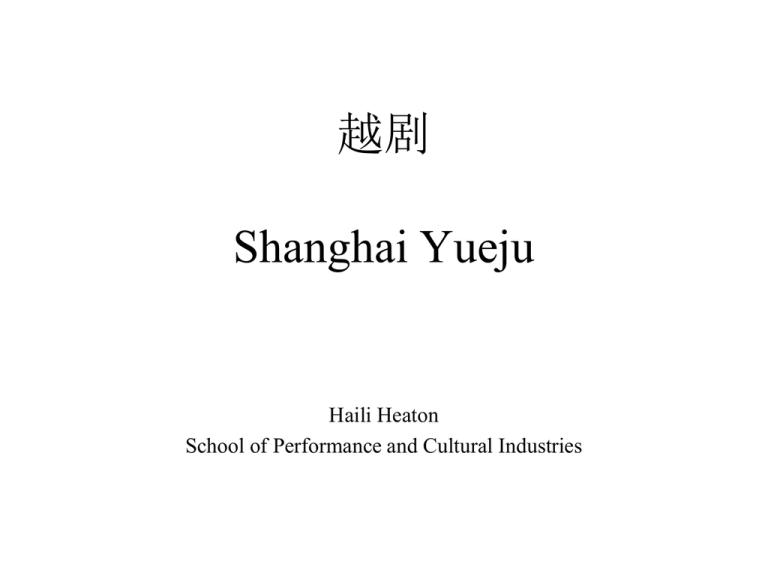
越剧 Shanghai Yueju Haili Heaton School of Performance and Cultural Industries Xiqu - Chinese opera • Definitions Xi/Ju: play, joke, game, etc.; Qu: music (Ci wei shi yu, qu wei ci yu) • From play (xi) to drama (xiju) Shaman (Nuoxi), Shang dynasty1766 B.C. Jester (Huaji xi/Canjun xi), Zhou dynasty 1066 B.C. speaking and singing art (Jiangchang/Bianwen), 800 A.D. From play (xi) to drama (xiju): use of role categories • Definition of Chinese opera (Xiqu) ‘(Xiqu) is to perform stories through dancing and singing … date from Song Dynasty (960 A.D. – 1279 A.D.)’ (WANG Guowei: Song Yuan Opera Record (Song Yuan Xiqu Kao, 1908) Shamanism play (Nuo xi) Beginning of Chinese opera, xiqu • Song, Yuan Varies Drama (Song Yuan Zaju) Song dynasty (960 –1279), Yuan Dynasty (1279 – 1368) Song: rise of trade/Yuan: scholars driven to popular entertainment from Baixi to Zaju: Wedge after each act/only one role sings in each act/women commonly act male role West Chamber (Xi Xiang Ji) by WANG Shifu • Ming Marvel Tale (Ming Chuanqi) Ming dynasty (1368 – 1644) singing not limited to one role a time/high literacy/Water refined tune(kunqu) developed to accompany Marvel tales – Kun opera Peony Pavilion (Mu Dan Tin) by TANG Xianzu • Qing dynasty (1644 – 1911) decline of Kun opera and rise of regional theatre: over 300 operas by end Qing/mass entertainment/low social statues Beijing opera, from regional to state patron opera/dan to sheng The Palace of Eternal Youth (Changsheng Dian) by Hong Sheng Rise of Spoken drama (Huaju) Yuan Varies Drama Ming Marvel Tale Kunqu Peony Pavilion Kunqu, The Palace of Eternal Youth Qing regional opera Mei Lanfang and Vsevold Meyerhold, 1935 Beijing opera face painting and acrobatic skills Shanghai Yueju • End of 19th century, Shenxian, Zhejiang province • Original form: Changshu (singing story), derived from Xunjun diao (Buddhist story telling tune) + local folk tunes • Names: Changshu - Xiaoge Ban (Little song troupe) – Didu ban (didu troupe) – Shaoxin Wenxi (Shaoxin civilian opera) – Yueju (Yue opera) • stage of development 1906, first performance 1906 – 1930s, male troupe in Shanghai 1923 – 1949, female troupe in Shanghai 1949 – 2004, centralized of Shanghai Yue opera – Shanghai Yue Theatre 2004 – today, marketization of Shanghai Yue Theatre 2006, centenary of Shanghai Yue opera Yushan theatre, Shenxian, Zhejiang province Famous male Yue opera performers in Shanghai, 1920 1923 – 1938, female Yue opera in Shanghai From 1923, first all female Yue opera troupe enter Shanghai to August 1938, Shanghai Yue opera has grown to become the most popular performing art. The following list shows the number of theatres specializing in different opera/huaju: 12 - Beijing opera, 3 - Shanghai opera, 2 - Play (huaju), 1 - Kun opera, 1 - Big Drum (Dagu) 12 - female Yue opera (GAO, 1991: 65). ‘An actor’s theatre’ • ‘It is a presentational style in which the conjoined elements of song, dance, mime, music, and dialogue are bound by set compositional and choreographic rules, to produce a total rhythmic flux realized through the self-sufficiency of the actor’s skill at all levels’ • ‘A typical play script is little more than a skeletal indicator … the actors with their instinctive command of form and content required no script to set a live performance in action … however, the most expressive acting in the light of Chinese critical acumen is the product of something more than sheer assimilation of technical forms by rote. …within the progression of the rhythmic permutations which provide the basic structure of any play, the actor’s total physical being is keyed to a pitch of instantaneous response at several levels, a transcendent deployment of his own dynamism, and it is to achieve this prized state that every actor is submitted to long and merciless training’ Scott, ed. by Mackerras, Chinese Theatre 1983 1940’s Reform of Shanghai Yue opera ‘Kunqu and Huaju are the two nannies of Shanghai Yue opera, … it was them who brought Yueju up’ (caress YUAN Xuefen, founder and first director of Shanghai Yue Theatre • REALISM ‘美轮美奂’ ‘beautiful voice, beautiful image’ – pure entertainment/escapism? make up, hair style, acting • Director’s theatre script, rehearsal, Xianglin Aunty (Xianglin Sao, 1946) Love of the Butterfly (Liangzhu) by Shanghai Yueju, 1954 Dream of the Red Mansion (Hong Lou Meng) by Shanghai Yue opera, 1958 1955, Shanghai Yue Opera Theatre 1956 – 1965, national development of Shanghai Yue opera 1980s, second ‘Golden period of Shanghai Yue opera’ 1990s, ‘Shanghai yue opera is the second most popular Chinese operas after Beijing opera’ (Survey of CCTV) 20th century: marketization of Shanghai Yue opera Spread of Shanghai Yue opera by 1965 Dream of the Red Mansion, Shanghai Yue Theatre 1983 Five Daughters’s at the Father’s Birthday Banquet by Zhejiang Hundred Flowers Yue Opera Company, 1983 The Library, by Zhejiang Hundred Flower Yue Company, 2002 Love of the Butterfly, by Shanghai Yue Theatre, 2004 ‘Alienation effects in Chinese Theatre’ - Bertolt Brecht Importance of symbols: Masks or painted face: character Head piece: a general Patched cloth: poverty Gesture: open a door, across a river Articles of furniture is carried onto stage: a horse whip, an oar Walking across a bridge Riding a horse ‘Chinese artist never acts as if there were a fourth wall besides the three surrounding him. He expresses his awareness of being watched. This immediately removes one of the European stage’s characteristic illusions … the actors openly choose those positions which will best show them off to the audience, just as if there were acrobats … he will occasionally look at the audience as if to say: isn’t it just like that?’ (Brecht, 1964: 91) The Chinese artist’s performance often strikes the Western actor as cold. … The coldness comes from the actor’s holding himself remote from the charcter portrayed, … he is careful not to make its sensations into those of the spectator. Nobody gets raped by the individual he portrays; … the Western actor does all he can to bring his spectator into the closest proximity to the events and the character he has to portray’ (93) 1906 – 2006 Centenary of Shanghai Yue opera haili@onetel.com

